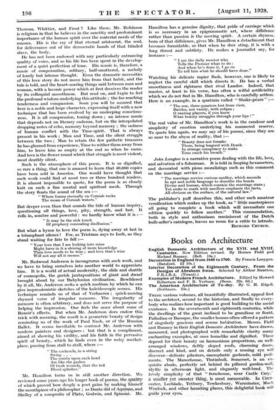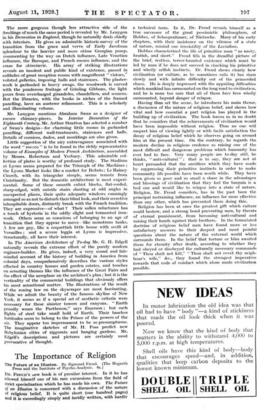Books on ArchitectUre English Domestic Architecture of the XVII. and
XVII!. Centuries. New Edition revised. By Horace Field. pnd Michael Bunney. (Bell. 18s.) Interior Decoration of the Eighteenth Century. From the Designs of Abraham Swan. Selected by Arthur Stratton, F.R.I.B.A. (Tiranti.)
The American Architecture of To-day. By G. H. Edged. (Scribners. 25s.)
THESE various volumes, all beautifully illustrated, appeal first to the architect, second to the historian, and finally to every- body who realizes how important is good building to the social existence. In the seventeenth and eighteenth centuries, while the dwellings of the great inclined to be grandiose or florid, Palladian or Baroque, the smaller houses often offered a pattern of singularly gracious and serene habitation. Messrs. Field and Bunney in their English Domestic Architecture have drawn, measured, and photographed with remarkable clarity many enchanting examples, at once homelike and dignified. These
depend for their beauty on harmonious proportions, on well- arranged windows, deftly sloped roofs, charming doors, discreet and kind, and on details only a musing eye will discover—delicate pilasters, unemphatic garlands, mild pedi- ments. The Manorhouse, Tintinhull, Somerset, is an ex-
quisite abode, perfectly set behind its pillared garden-wall, idyllic in afternoon light, and elegantly well-bred. The
loirely simplicity of that " farmhouse, near Castle Cary,'
a smaller yet sweeter thing, is most memorable. In Ciren- cester, Lechlade, Tetbury, Tewkesbury, Warminster, Much Wenlock, and other haunting places, this delightful book will guide your eyes. The more, gorgeous though less attractive side of the dwellings of much the same periOd is revealed by Mr. Lenygon
in his Decoration in England, though he naturally deals chiefly with interiors. He gives an admirable historic survey of the transition from the grace and verve of Early Jacobean splendour to the heavier and more otiose Georgian pomp, commenting by the way on Dutch influence, Late Venetian influence, the Baroque, and French rococo influence, and the craze for chinoiserie. His array of striking illustrations reveals an insolent and public kind of existence, passed in enfilades of great reception rooms with magnificent " vistoes,'' voluted galleries, imposing halls and staircases. The plaster- work is garlanded in heavy swags, the woodwork is carved with the ponderous fruitage of Grinling Gibbons, the light pours from overcharged girandoles, chandeliers, and sconces. But the libraries, with the books in niches of the framed panelling, have an austerer refinement. This is a scholarly and illuminating volume.
Mr. Lenygon mentions Abraham Swan as a designer of rococo chimney-pieces. In Interior Decoration of the Eighteenth Century, Mr. Arthur Stratton has selected a number of Swan's desigirs—for charming little rooms in garlanded panelling, different wall-treatments, staircases and halls. Details of cornices, dados, and mouldings are also given.
Little suggestion of the airy extravagance associated with the word " rococo " is to be found in the richly representative volume of Examples of Modern French Architecture, assembled by Messrs. Robertson and Yerbury. This admirable col- lection of plates is worthy of profound study. The Stadium at Lyons seems prepared for the Triumph of the Machines ; the Lyons Market looks like a market for Robots ; Le Rainey Church, with its triangular steeple, seems remote from Christianity. But the domestic architecture is most experi- mental. Some of these smooth cubist blocks, flat-roofed, sharp-edged, with outside stairs slanting at odd angles in unexpected places, their quite adequate windows cunningly arranged so as not to disturb their blind look, and their secretive inhospitable doors, distinctly break with the French tradition. They are expressive—of what ? Their sullen reluctance has a' touch of hysteria 'in the oddly slight and tormented iron- work. Others seem so conscious of belonging to an age of transition that they appear to move—like monstrous tanks. A few are gay, like a coquettish little house with ocelli at Versailles ; and a severe loggia at Lyons is impressive. Structurally, all have their interest.
In The AmeriCan Architecture of To-day Mr. G. H. Edgell naturally reveals the extreme effort of the purely modern engineer-builder. He gives, indeed, a very sound and fair- minded account of the history of building in America from colonial days, comprehensively describes the various styles affected in country houses and garden estates, and touches on arresting themes like the influence of the Great Fairs and the effect of the aeroplane on the architect's plan ; but it is the verticality of the commercial buildings that obviously offers his most sensational matter. The illustrations of the result of the zoning law on the skyscraper are most fascinating. While we admit the beauty of the famous skyline of New York, it seems as if a special set of aesthetic criteria were necessary for these sinister towers and canyons. " Earth Proudly wears the Parthenon," says Emerson ; but such flights of steel take small hold of Earth. Their baseless fortitudes seem to belong to the Prince of the powers of the air. They appear too impermanent to be so presumptuous. The imaginative sketches of Mr. H. Foss predict new Babylonian cities of ziggurats and hanging gardens. Mr. Edgell's descriptions and pictures are certainly most provocative of thought.





























 Previous page
Previous page